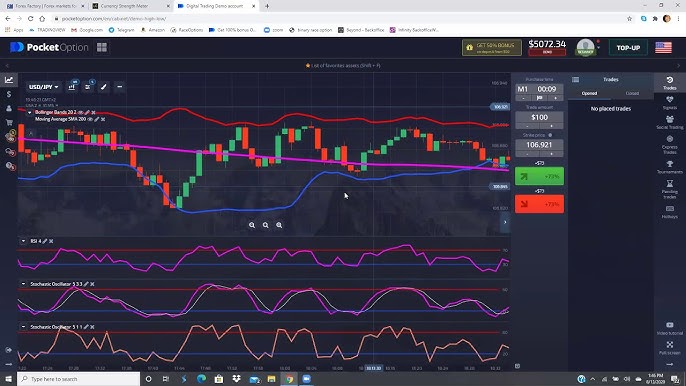
Understanding Pocket Option Trade
Pocket Option Trade is an increasingly popular platform for many traders seeking to venture into the world of financial trading. With its user-friendly interface and versatile trading options, it attracts both novice and seasoned traders alike. If you’re curious about how to maximize your trading experience, Pocket Option Trade Pocket Option FR is a great resource to begin with.
What is Pocket Option?
Pocket Option is a digital trading platform that allows users to trade a variety of financial instruments, including stocks, cryptocurrencies, commodities, and forex. Founded in 2017, the platform quickly gained popularity due to its innovative approach to binary options trading. One of the distinguishing features of Pocket Option is its demo account option that allows traders to practice and refine their strategies without the risk of losing real money.
Getting Started with Pocket Option Trade
To begin your trading journey on Pocket Option, you’ll need to follow these simple steps:
- Create an Account: Visit the Pocket Option website and sign up for a free account. You’ll need to provide some basic personal information and accept their terms and conditions.
- Verify Your Account: To ensure the security of your funds and personal data, Pocket Option requires verification. Typically, this involves submitting identification documents.
- Deposit Funds: Once your account is verified, you can deposit funds using a variety of payment methods, including credit/debit cards, bank transfers, and cryptocurrencies.
- Explore the Platform: Familiarize yourself with the trading environment, including chart tools, asset lists, and the various trading options available.

Trading Strategies for Pocket Option
Successful trading on Pocket Option involves understanding market dynamics and employing effective strategies. Here are a few common trading strategies that can help bolster your trading endeavors:
1. Trend Following
The trend-following strategy is predicated on identifying and capitalizing on existing market trends. Traders using this strategy typically analyze price movements and use tools like moving averages to determine the direction of the market. When a clear trend is established, they place trades in the direction of that trend.
2. Momentum Trading
Momentum trading focuses on stocks or assets that are moving significantly in one direction on high volume. Traders using this strategy believe that strong price movements are likely to continue, and they aim to enter trades that align with momentum. Indicators like the Relative Strength Index (RSI) and MACD are popular for this strategy.
3. Scalping
Scalping involves making quick trades to capture small price movements. This is a fast-paced strategy that requires quick decision-making and disciplined risk management. Several trades might occur within one trading session, and it’s essential to have strategies for entering and exiting trades quickly.
Risk Management in Pocket Option Trading
While trading can be profitable, it also poses risks. Implementing sound risk management practices is crucial to protect your capital:
- Set Stop-Loss Orders: A stop-loss order automatically sells your position when the asset reaches a certain price. This limits potential losses and protects your capital.
- Only Risk What You Can Afford to Lose: Establish a budget for your trading activities and only invest money you can afford to lose. This will prevent emotional decision-making and help maintain discipline.
- Diversification: Avoid putting all your funds in one trade or financial instrument. By diversifying your portfolio, you spread risk across multiple assets.
The Role of Trading Indicators

Trading indicators are tools that help traders analyze market conditions and make informed decisions. In the context of Pocket Option, some commonly used indicators include:
- Moving Averages: These are used to identify trends and reversals. They smooth out price action and help traders spot potential entry and exit points.
- Bollinger Bands: These provide information about price volatility and help traders identify overbought or oversold conditions.
- Fibonacci Retracement: This is a popular tool used to identify potential reversal levels based on the Fibonacci sequence.
Understanding Market Analysis
To become successful with Pocket Option Trade, you need to understand different types of market analysis:
1. Fundamental Analysis
This involves evaluating economic indicators, news events, and financial reports to assess the value of a particular asset. Traders who use fundamental analysis prioritize long-term trends.
2. Technical Analysis
Technical analysis focuses on historical price movements and utilizes charts and indicators to forecast future price behavior. It is more popular among traders looking for shorter-term trading opportunities.
3. Sentiment Analysis
This approach analyzes the mood of market participants based on current trends. Understanding sentiment can help traders exploit psychological factors that influence price movements.
Conclusion
Pocket Option Trade offers a dynamic and accessible platform for both new and experienced traders to engage in financial markets. By understanding trading principles, employing strategies, managing risk, and using the right tools, traders can maximize their potential for profitability. Remember to continually educate yourself, stay updated on market trends, and refine your strategies over time for the best outcomes. Investing time in learning will pay dividends in the long run.
